Bauer 4-out 1-in motion
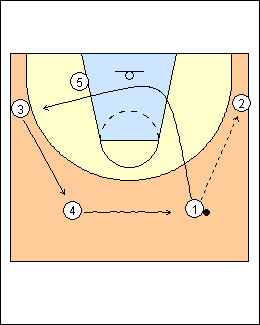 | 1 Jeff Bauer 4-out motion is a viable secondary zone attack. Stretch the zone with 1 and 4 high and wide, 2 and 3 down far enough to force baseline defenders to guard them. Perimeter players look to line up in the gaps of the defence, they can cut or screen then space out behind the defence, then up. Basket cuts do not usually lead directly to scores, but they flush out defenders and clear the top for subsequent cutters. Make the defence shift with ball reversal - consider a "swing rule" that the ball must swing to the other side before it can go back in the direction of the previous pass, except possibly on a fake swing pass. Use a two-inch pass or shot fake on almost every catch except for an immediate shot or drive. 5 begins behind the zone on the baseline to create larger gaps for passes and drives, plays in a triangle from short corner to short corner to above the top of the circle, and uses a mix of screening, sealing, and cutting. Get the ball into the post on every possession. Villanova - try to run your man-to-man offence against zones, don't worry about recognizing one-guard or two-guard fronts, focus on scoring. Get your shooters in, any zone offence looks great with four shooters on the floor. |
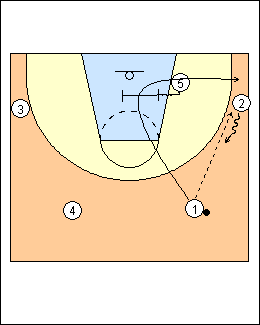 | 2 Dribble penetration is more effective against a zone than a man defence because recovery assignments are not as clear, and is best done after a quick swing. Drive directly into a gap or at the inside shoulder of an outside defender, off-ball attackers re-locate, then kick or use an "air dribble" (bully move) to get into the paint. Place a driver between two shooters. Freeze dribble directly at a defender, allowing a clearer passing angle. Also dribble to take a defender away from his coverage area, e.g., dribble looping (shallow cut), or dribbling out of the corner (dribble following), which can be enhanced with a pin screen by the post (shown). 5 pin screens the defender responsible for the short corner, then looks to screen the next baseline defender. |
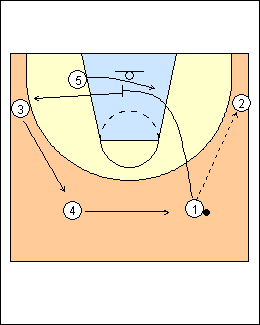 | 3 Screening the slides of a zone is crucial. After basket cutting, a perimeter player can centre screen the defender responsible for guarding 5, then space out and up (shown). Perimeter players may also cut to open areas, especially when done behind the defence. |
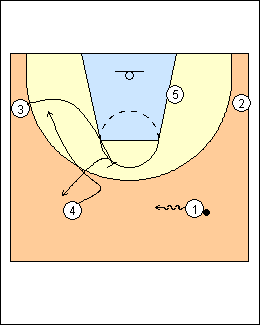 | 4 Flare screens generate swings and open looks (screen the defender guarding you, not the man guarding the cutter). |
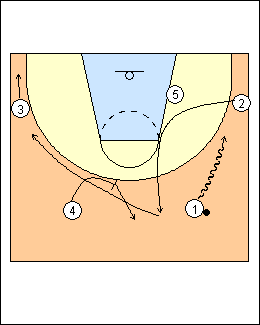 | 5 An excellent time to flare screen is after dribble looping (dribble loop flare). If the cutter is covered, the screener will be open for a slip or out cut. |
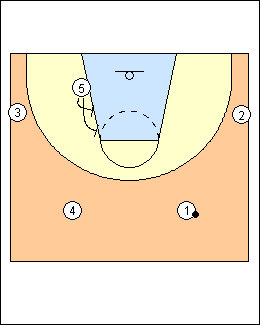 | 6 Pin screens are also very effective, and should be a staple screen by 5. Pins lead to swings then post feeds. Pin screen the defender who covers ball reversal, usually a wing defender in an odd-front zone and a bottom defender in an even-front zone. If the defender goes under the screen, roll him out (an incidental screen); if the defender goes over, release and look to seal the next defender. Ettore Messina - if the outside defender goes over the screen, allow him to come outside if 5 can get good inside position for a pass close to the basket. If 4 gets a pass from 1, a pass fake to 3 would improve the likelihood of a pass to 5. |
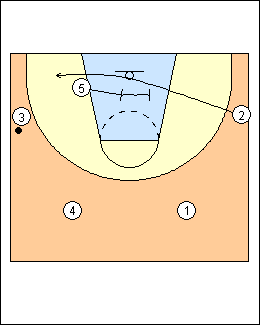 | 7 Centre screening can be used to bring the opposite wing to the ballside short corner. 5 screens the centre defender, then looks to seal the next baseline defender for a post feed or rebounding position. Sealing in is the most common seal. However, if a defender gets (or cheats) outside the post attacker, then 5 looks to seal him out, getting inside position on ball reversal. The big will also look to seal up, preventing defenders from covering the low post and baseline. |
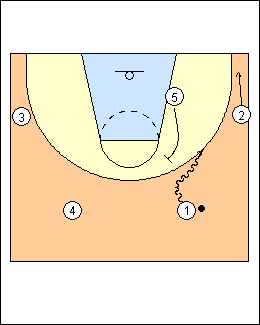 | 8 Post ballscreens can help with dribble penetration. |
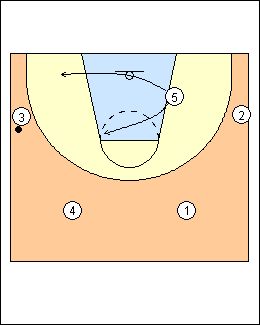 | 9 Post cutting keeps the defence moving, but post players should not get into the habit of chasing the ball (one duty is offensive rebounding). A post cutter should banana cut to open area behind defenders, especially the short corner and high post. |
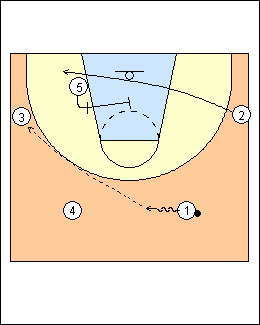 | 10 Entries a) Swing the ball to three players Reversing the ball to three players creates an immediate overload. 5 pin screens to help clear the skip passing lane, then steps into the next baseline defender to post up and bring 2 to the ballside short corner. 5 could then even look to seal a third defender. See Zone set plays - UConn point, Bill Self (#3). |
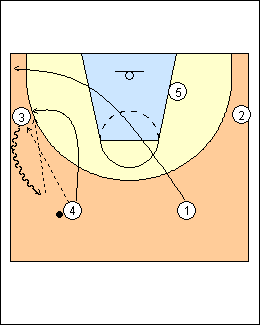 | 11 b) Buddy cutting Two offensive threats cut to the same area of the floor, creating an overload. 4 is a driver, 1 is a shooter. (Variation - Boise State - 5 ballscreens for 3) See Zone set plays - Overload. |
This page was made with Basketball playbook from Jes-Soft